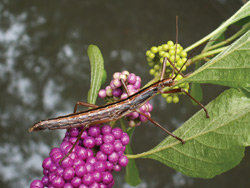|
|
Tiny Probe Allows Imaging Of Small Samplesdownloadable pdf
Good things may indeed come in small packages for scientists eager to find natural substances to help cure diseases. The challenge is to analyze material that is smaller than the proverbial gnat’s eyelash. But using a refined version of nuclear magnetic resonance technology, or NMR, scientists have unlocked secrets hidden in tiny amounts of venom taken from spindly insects called common two-stripe walking sticks, which are relatively harmless, plant-eating creatures common in the eastern United States. The analytical technique, described in the journal ACS Chemical Biology by scientists at UF’s McKnight Brain Institute and the Center for Medical, Agricultural and Veterinary Entomology at the Gainesville U.S. Department of Agriculture, could aid in the search for natural substances to make medicines. It also shows that scientists can obtain volumes of information from very tiny samples, which could be useful in efforts to understand Alzheimer’s disease and other disorders. “There are many potent, useful molecules made by plants and animals, but they are usually produced in such small quantities it takes a huge amount of material to characterize them,” said Arthur Edison, an associate professor of biochemistry and molecular biology. “In this case, it previously required hundreds of milkings to get enough walking stick venom for analysis. We were able to get great data from just one milking.” Researchers equipped an NMR spectrometer with a special probe to examine the venom, which the walking stick sprays to defend itself from predators. Similar to the magnetic resonance imagers used to examine patients in hospitals, this analytical tool uses much stronger magnetic fields to study smaller samples, allowing scientists to study molecules atom by atom. But what made this particular method unique is not the extreme power of the magnet, which at 600 megahertz is fairly standard, but the extreme sensitivity of the probe — the component that is inserted into the magnet to obtain chemical information from the samples. Developed by scientists at the National High Magnetic Field Laboratory at UF and in Tallahassee, and a manufacturer of NMR equipment, the probe is only about 2 inches in diameter, and the space for the sample itself is about 1 millimeter in diameter. When in use, the probe is cooled to lower than 400 degrees Fahrenheit below zero to reduce electrical signals that would interfere with the analysis. But the sample area itself is kept warm to protect the specimen. “It is now possible to approach problems we couldn’t think about before,” said Edison, who said he welcomes collaboration with other scientists interested in using the new probe. “For example, in mouse models of Parkinson’s or Alzheimer’s disease, there is not a lot of tissue to work with, especially if you’re studying a sample from a single animal. But this is a way we could obtain potentially important chemical information about disease from small amounts of brain tissue.” Scientists used walking stick venom to demonstrate the technique partly because it combined lead researcher Aaron Dossey’s passion for studying insects with his formal training in biochemistry. “I’ve raised different species of walking sticks, which are well known to spray defensive venom,” Dossey said. “We thought if this technique really can look at small samples, well, a milking of a single walking stick is very small. It’s worth a try.” Arthur Edison, art@mbi.ufl.edu |

